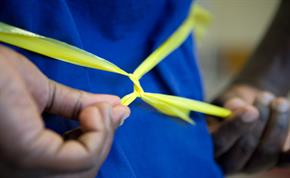The World Health Organization (WHO) has today declared the spread of Ebola in west Africa an international health emergency. Ebola is one of the worst viral haemorrhagic diseases known and is a Category Four pathogen. There is currently no known prevention or cure and it is said to have up to a 90% fatality rate.
There is a two-to-21 day incubation period for this disease, so please be aware of any patient who presents, either on the phone or on scene, with symptoms of:
- a fever >380C or history of fever in the previous 24 hours
- travel history to west Africa in the last 21 days (especially Guinea, Sierra Leone, Liberia and Nigeria)
- joint and muscle pain
- sore throat, intense weakness and chest pain
- difficulty with breathing and/or swallowing.
- diarrhoea and vomiting with associated stomach pain
- internal and/or external bleeding (bruising could be present)
- some patients may develop a rash, red eye and hiccups.
The following action should be taken:
- inform control and ask for further support from the duty locality officer (DLO) and to inform the local resilience officer. On-call managers should be used as appropriate.
- don the relevant PPE explaining to the patient and the family that there is no need to be alarmed, however your procedures state these items have to be worn just in case there is an infection present.
- make patient safe, and comfortable on the vehicle – ensure it is safe to carry the patient on your vehicle by use of incontinent sheets, pads, bandages etc., if the patient is losing any body fluids, and ensure a vomit bowl is readily to hand.
- call your local A&E unit prior to leaving to ensure they are able to accept the patient – if not, other arrangements can be made regarding transport to the Infectious Disease Unit, which is at the Royal Free Hospital in London. The Trust’s resilience advisor will liaise with the on-call public health consultant for full instructions at this stage.
- if patient requires cannulation, ensure the sharps box is in close proximity, double glove for the insertion, be exceptionally careful with the used sharp, dispose of in the sharps box, shut the lid securely and ensure the entire container is disposed of after the case, with the box marked as ‘infectious – for incineration’.
- if you have any contact with blood or body fluids, ensure the area is washed immediately, utilising soap and water if available or saline solution; also any contact with mucous membranes must be washed out with a copious amount of saline, and you should refer to the receiving hospital immediately and to Occupational Health.
- when ready to leave scene, the driver must remove PPE outside the vehicle, roll up the PPE and hand to the attendant to dispose of in the clinical waste bag – the driver should then use their own individual hand sanitiser once rear ambulance doors are closed. Do not drive in PPE.
- if DLO/on-call officer has arrived, they can remove any equipment from the vehicle that is not required for the case and also any of the staff belongings and bags, which can be placed securely in the officers’ vehicle. They should then escort the crew to the relevant hospital – no contact with the patient is necessary for the DLO/on-call officer unless they are the only paramedic on scene, in which case they may need to change places with the attendant depending on the patient’s condition.
- on arrival at hospital, the driver (or escorting on-call officer) will need to go into the receiving department to announce their arrival, and obtain details of the isolation room for the patient.
- the driver must then don further, relevant, clean PPE obtained from either the escorting officer or the hospital staff.
- once patient is handed over, remove all used linen and either leave it with the patient, or ask advice regarding whether to place in the hospital ‘contaminated laundry bag’ or a red incinerator bag.
Please ensure that the following strict IPC (infection prevention and control) precautions are employed:
- scrupulous hand hygiene – regular use of sanitiser gel and wipes and using soap and water when they are available
- wear PPE (personal protective equipment) – apron or overalls, sleeve protectors and gloves – to cover all clothing and exposed skin
- if the patient has respiratory symptoms or there is a risk of splash, use a surgical mask with visor, or FFP3 with goggles
- extra care is required for any procedure involving sharps to ensure there is no contact whatsoever with blood or body fluids
The following actions are needed after the patient is handed over;
- the stretcher should be thoroughly cleaned using vehicle based wipes, followed by Actichlor disinfectant (in a well-ventilated area). Do not replace the stretcher onto the vehicle until the vehicle has also been cleaned, unless the vehicle is going back to the station for a deep clean
- all surfaces in the vehicle will require wiping with the vehicle-based wipes and will also require wiping with Actichlor – this can be done by the crew wearing clean, full, PPE or by ambulance fleet teams wearing full PPE
- all equipment used will need to be thoroughly cleaned using detergent followed by Actichlor.
Further guidance on Actichlor can be found in the vehicle cleaning manual on East24.
It is important to note that the current threat to the UK remains low.
More information will be published on Need to Know regularly.
Download a printable copy of this information as a clinical bulletin to put up in your office or station - please click this link.
Published 8th August, 2014
